

Marin & Halpern (2011).pdf. Clear thinking Archives - Academic Skills plus. Responsible Thinking: An Approach to Critical Thinking. How To Think Critically. Critical Thinking Model 1. To Analyze Thinking We Must Identify and Question its Elemental Structures Standard: Clarityunderstandable, the meaning can be grasped Could you elaborate further?
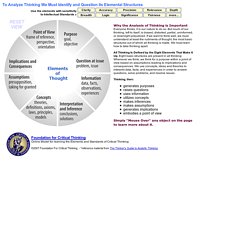
Could you give me an example? Could you illustrate what you mean? Standard: Accuracyfree from errors or distortions, true How could we check on that? Standard: Precisionexact to the necessary level of detail Could you be more specific? Standard: Relevancerelating to the matter at hand How does that relate to the problem? Standard: Depthcontaining complexities and multiple interrelationships What factors make this a difficult problem?
Standard: Breadthencompassing multiple viewpoints Do we need to look at this from another perspective? Standard: Logicthe parts make sense together, no contradictions Does all this make sense together? Standard: Significancefocusing on the important, not trivial Is this the most important problem to consider? Standard: FairnessJustifiable, not self-serving or one-sided Think About... State the Question. Barriers to Critical Thinking - Another Look. By Denis Korn Evaluate - Embrace - Embody I am posting once again what has been one of the most read of all my posts.
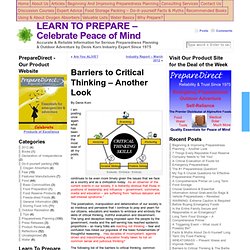
It continues to be even more timely given the issues that we face as a country and as a civilization today. As an observer of the current events in our society, it is blatantly obvious that those in positions of leadership and influence – government, commerce, media and education – are suffering from “serious delusion and self-interest syndrome.” The polarization, manipulation and deterioration of our society is so insidious and pervasive that I continue to pray and yearn for our citizens, educators and leaders to embrace and embody the skills of critical thinking, truthful evaluation and discernment. Critical thinking. Simons Lab. Most of the videos on this site are also available on Prof.
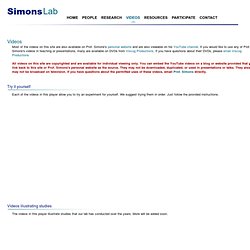
Simons's personal website and are also viewable on his YouTube channel. If you would like to use any of Prof. Simons's videos in teaching or presentations, many are available on DVDs from Viscog Productions. If you have questions about their DVDs, please email Viscog Productions All videos on this site are copyrighted and are available for individual viewing only. Each of the videos in this player allow you to try an experiment for yourself. The videos in this player illustrate studies that our lab has conducted over the years. Intute: Encouraging Critical Thinking Online. Encouraging Critical Thinking Online is a set of free teaching resources designed to develop students' analytic abilities, using the Web as source material.
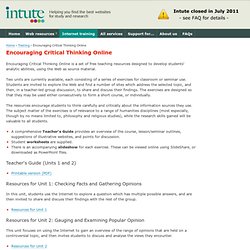
Two units are currently available, each consisting of a series of exercises for classroom or seminar use. Students are invited to explore the Web and find a number of sites which address the selected topic, and then, in a teacher-led group discussion, to share and discuss their findings. The exercises are designed so that they may be used either consecutively to form a short course, or individually. The resources encourage students to think carefully and critically about the information sources they use. The subject matter of the exercises is of relevance to a range of humanities disciplines (most especially, though by no means limited to, philosophy and religious studies), while the research skills gained will be valuable to all students. Teacher's Guide (Units 1 and 2) Printable version (PDF) Resources for Unit 1. Why People Believe Weird Things and 8 Ways to Change Their Minds.
Some people believe all kinds of weird stuff including… …no, actually, for a very good psychological reason I’m not going to repeat any of it here.
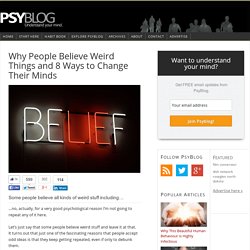
Let’s just say that some people believe weird stuff and leave it at that. It turns out that just one of the fascinating reasons that people accept odd ideas is that they keep getting repeated, even if only to debunk them. So, where does all this misinformation come from, why do people believe it and how can right-thinking people counter it?
(The following is based on an excellent article by Professor Stephan Lewandowsky and colleagues). Where misinformation comes from 1. People love sensational stories. Neutral stories, which are probably more likely to be true, but much more boring, therefore get short shrift. 15 Styles of Distorted Thinking. 10 Brilliant Social Psychology Studies. Ten of the most influential social psychology experiments.

“I have been primarily interested in how and why ordinary people do unusual things, things that seem alien to their natures.Why do good people sometimes act evil? Why do smart people sometimes do dumb or irrational things?” –Philip Zimbardo Like eminent social psychologist Professor Philip Zimbardo (author of The Lucifer Effect: Understanding How Good People Turn Evil), I’m also obsessed with why we do dumb or irrational things. The answer quite often is because of other people – something social psychologists have comprehensively shown. Over the past few months I’ve been describing 10 of the most influential social psychology experiments. Each one tells a unique, insightful story relevant to all our lives, every day. 1. The ‘halo effect’ is a classic social psychology experiment. » Read on about the halo effect -» 2. » Read on about cognitive dissonance -» 3. » Read on about Sherif’s Robbers Cave experiment -» 4. 5. 6. 7. 8. 9. 10.